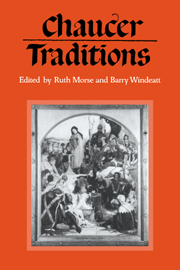Book contents
- Frontmatter
- Contents
- List of contributors
- Preface
- Note on the text
- 1 Chaucer traditions
- 2 Gower–Chaucer's heir?
- 3 Chaucer and Lydgate
- 4 Hoccleve and Chaucer
- 5 Chaucer and fifteenth-century romance: Partonope of Blois
- 6 Some Chaucerian themes in Scottish writers
- 7 The planetary gods in Chaucer and Henryson
- 8 Gavin Douglas: ‘Off Eloquence the flowand balmy strand’
- 9 Skelton's Garlande of Laurell and the Chaucerian tradition
- 10 Chaucerian metre and early Tudor songs
- 11 Aspects of the Chaucerian apocrypha: animadversions on William Thynne's edition of the Plowman's Tale
- 12 The shape-shiftings of the Wife of Bath, 1395–1670
- 13 The genius to improve an invention: transformations of the Knight's Tale
- 14 From the Clerk's Tale to The Winter's Tale
- 15 The Virtuoso's Troilus
- 16 Rewriting romance: Chaucer's and Dryden's Wife of Bath's Tale
- 17 Chaucer's religion and the Chaucer religion
- 18 A list of the published writings of Derek Brewer
- Index
13 - The genius to improve an invention: transformations of the Knight's Tale
Published online by Cambridge University Press: 23 September 2009
- Frontmatter
- Contents
- List of contributors
- Preface
- Note on the text
- 1 Chaucer traditions
- 2 Gower–Chaucer's heir?
- 3 Chaucer and Lydgate
- 4 Hoccleve and Chaucer
- 5 Chaucer and fifteenth-century romance: Partonope of Blois
- 6 Some Chaucerian themes in Scottish writers
- 7 The planetary gods in Chaucer and Henryson
- 8 Gavin Douglas: ‘Off Eloquence the flowand balmy strand’
- 9 Skelton's Garlande of Laurell and the Chaucerian tradition
- 10 Chaucerian metre and early Tudor songs
- 11 Aspects of the Chaucerian apocrypha: animadversions on William Thynne's edition of the Plowman's Tale
- 12 The shape-shiftings of the Wife of Bath, 1395–1670
- 13 The genius to improve an invention: transformations of the Knight's Tale
- 14 From the Clerk's Tale to The Winter's Tale
- 15 The Virtuoso's Troilus
- 16 Rewriting romance: Chaucer's and Dryden's Wife of Bath's Tale
- 17 Chaucer's religion and the Chaucer religion
- 18 A list of the published writings of Derek Brewer
- Index
Summary
In his long Preface to the Fables, Dryden not only compares the authors of the stories he translates for the collection, but also discusses their sources. What he says about the first of the tales is very interesting in this respect. After giving the ‘Noble Poem’ of Palamon and Arcite an epic status ‘perhaps not much inferiour’ to that of the Iliad and the Aeneid, Dryden maintains that he had thought this story to be ‘of English Growth, and Chaucer's own’. But, he adds,
I was undeceiv'd by Boccace; for casually looking on the End of his seventh Giornata, I found Dioneo (under which name he shadows himself) and Fiammetta (who represents his Mistress, the natural Daughter of Robert King of Naples) of whom these Words are spoken. Dioneo e Fiametta gran pezza cantarono insieme d'Arcita, e di Palamone: by which it appears that this Story was written before the time of Boccace; but the Name of its Author being wholly lost, Chaucer is now become an Original; and I question not but the Poem has receiv'd many Beauties by passing through his Noble Hands.
It is rather strange that, having made the connection between Boccaccio, the author of the Decameron, and Dioneo, one of the characters in the Decameron's frame who is said to have ‘sung’ of Arcite and Palamon, Dryden should not suspect that the story had been first written by Boccaccio himself.
- Type
- Chapter
- Information
- Chaucer TraditionsStudies in Honour of Derek Brewer, pp. 185 - 198Publisher: Cambridge University PressPrint publication year: 1990
- 3
- Cited by

